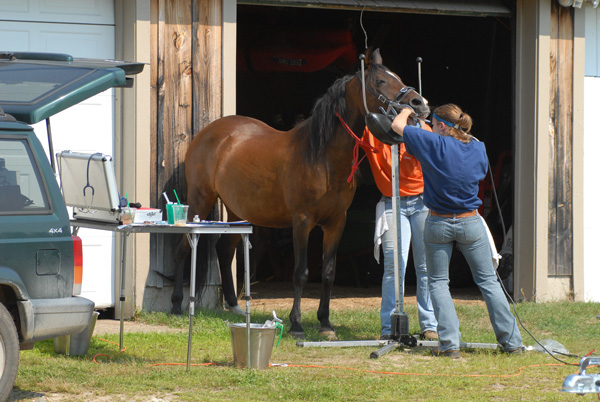The budget is the financial strategic plan used by a business; it takes into account the financial objective as well as market forces that define profitability. A budget (from the old French bougette, meaning purse) is a list of all planned expenses and revenues.

The purpose of budgeting is to provide a forecast of revenues and expenditures. When reviewed in conjunction with financial statements, a budget enables the actual financial operation of the business to be measured against the forecast.
Unfortunately, few equine practices have a budget, and almost none use a budget effectively as a management tool.
A budget presents you with an opportunity to manage your practice through the windshield instead of in the rear-view mirror. If you only study your financial statements, you are looking at what has happened to your business, not what will happen.
Often budgets are prepared with only one goal in mind, to make a profit. However, it isn’t enough to simply turn a modest profit from one year to the next if you want to enhance your enterprise value. Additional factors should be considered in order to increase the value of your practice now, thus the value to any future partners or potential buyers at retirement or when planning to exit.
Practices should budget to make a profit and set goals of sustaining performance that will create a positive net income to meet the debt service required for potential investors.
Preparing a budget takes time. A budget should not be viewed as a failure if actual financial performance varies from the budget.
There are several components to effective budgeting:
· Compiling a reasonable budget
· Sticking to the budget
· Routinely comparing actual performance to the budget and adjusting or modifying the budget as new trends develop or as operations may require.
Budgeting can be an eye-opening education into your practice operations. A budget requires knowledge of the basic components of financial reporting: the income statement or profit-and-loss statement (P&L), the balance sheet and a cash-flow statement. The P&L statement is the report on which budgeting relies most heavily.
Getting Started
It is recommended to be conservative when first creating a budget. The conservative approach tends to overestimate expenses and underestimate revenues. This should not be so conservative that you worry about going over or under budget each month. Your projections are simply your best guesses based on your current performance and assumptions for the upcoming year.
Begin the budgeting process by reviewing your prior year’s P&L statement for an understanding of your net income or loss and the revenue and expense categories. You can print your previous year’s P&L statement and mark it up to create your budget, or you can drop the P&L statement into an Excel document and build the budget electronically.
There are software accounting programs that can help you in this process. For example, Quick Books has a budget function that is a good place to start.
Many find it easier to break down the practice’s P&L statement into categories to assist in the budgeting process. Some practices have multiple profit centers or income-generating departments. Other practices simply record all operations under one central company.
If your income and expenses are reported in a few “big buckets,” it is difficult to build a meaningful budget. The more detail you see on your P&L statement (for both income and expenses), the more effective your budget will be.
Budgeting Revenues
No matter how your financial information is organized, the best approach is to begin with your revenues. Since many expenses can vary based on the volume of sales or services provided, determine estimated annual revenues for the company, profit centers, service areas, by veterinarian, etc., depending on the level of detail you are willing to calculate or are capable of obtaining.
When estimating future projections for revenue, it is important to review the following:
· Industry and economic trends
· Pricing and services offered
· Price increases and volume
· Will increasing prices add to revenue dollars?
· Will price increases have a negative effect and decrease the quantity sold or services provided, thus lowering total dollars?
· Can a volume increase of certain services be obtained without a price adjustment?
· Can your practice provide new services or bundled options to increase revenue?
· Wellness programs
· New diagnostic services and procedures
· Medication and supply purchasing programs
· Existing clients
o Do they anticipate maintaining the same number of horses in the upcoming year?
o Are there any services they will be eliminating, reducing or adding to their farm management program?
· New clients
o Is there potential for obtaining new clients?
o Are there new areas or locations in which to advertise your services?
Of course, trends and assumptions will be unique for each practice. It is necessary to have a clear understanding of these trends in order to effectively assess your practice revenue potential for the short-term budget and long-term growth of your practice and potential practice value.
Expenses
Budgeting the expenses can take more time and thought, as there are fixed expenses and variable expenses.
Fixed expenses are those that do not change, such as a mortgage payment or a lease. Variable expenses are just that, they vary from month to month. Supplies can be lumped in this category as re-orders are based on usage and usage can vary greatly from month to month or year to year.
It is easiest to identify the fixed expenses first and plug those expenses in accordingly. There are many methods that practices can use when budgeting expenses. The key is to focus on the type of expense, then evaluate what factor’s could have an impact on whether that expense increases or decreases. Using those assumptions you can reasonably estimate any kind of expense.
You should further identify those expenses that are a significant portion of your total expenses. In most practices that includes drugs/medical supplies and salaries/wages.
Take-Home Message
Budgeting is not an exact science. However, it requires a good knowledge of your practice operations and realistic expectations for revenue increases and reduction of expenses.
Often a simple detailed look at
revenues and their sources can identify new opportunities for growth, or reveal services that are underpriced. That detailed look can also give you additional awareness of expenses, which can result in elimination of unnecessary operational expenses or help you identify operating inefficiencies that can result in expense reductions.
Often practices and companies prepare a budget, but do little to monitor their progress against the budget. Further analysis—with a detailed look at operations and expenses and testing “what-if” scenarios for profits and expenses—can yield larger savings and an enhanced awareness of the practice’s operations.
It is common that companies will occasionally fall short of achieving some budget projections. Examine these variances routinely to understand their cause. The variances might simply be a result of an overly aggressive budget, such as projecting revenues too high.
Sometimes, budget shortfalls can be a result of underestimating expenses. Or it could be that you budgeted expenses reasonably, but the practice is spending too much and a stricter policy of adhering to the budget needs to be put in place.
The key to successful budgeting is to review your performance routinely (preferably monthly). This will allow for more timely adjustment of actual expenditures and any reallocation of budget shortfalls. In addition, routine review will assist you in staying “on the pulse” of your practice operations and assist in managing the cash flows of the company to ensure you are meeting obligations.
Utilizing these tools and being proactive in generating a budget can prepare any practice for unexpected events and help you better manage the shortfalls as well as the excess income that is earned. These are key to reaching your professional goals.
Author Bio: Andrew R. Clark, DVM, MBA, is founder and president of Andrew R Clark, DVM, MBA, LLC. You can find out more about him and his services at dvmmba.com.
SIDEBAR
Budgeting for Veteran Practitioners
Many veterinarians have successfully run their businesses for decades without complicated budgeting and analysis. However, as you get closer to planning retirement, those numbers become more important to you as selling tools for your business. Toward that end you need an exit strategy, which is defined as the planned exit of an owner from his or her business.
Selling or otherwise disposing of a veterinary practice requires some forethought, strategic planning and careful implementation. In some ways, getting out of a business is more complicated than starting a business. For instance, while there’s really only one way to start a company, there are at least three primary methods for entrepreneurs to leave businesses they founded: selling, merging and closing.
When I manage a business, I start by defining the objective of the business. There are several objectives a business might choose; among them are profit, cash flow and sustained enterprise value. (According to Investopedia.com: “Think of enterprise value as the theoretical takeover price. In the event of a buyout, an acquirer would have to take on the company’s debt, but would pocket its cash.”)
Since almost everyone expects to be able to sell his or her practice, I always begin with the objective of generating enough profit to support enterprise value. If you don’t manage your business with that objective, it will probably be very difficult—if not impossible—to sell your practice. Very few people want to take on a business that has more money going out than coming in.
Support your enterprise value as a key budgeting objective, and you can always keep your eye on the prize: your exit strategy! Instead of waiting until the day you need to sell to learn if you have a viable business someone else wants, you will know month by month and year by year what management changes you need to implement to sustain your enterprise value. —Andrew R. Clark, DVM, MBA

![[Aggregator] Downloaded image for imported item #18375](https://s3.amazonaws.com/wp-s3-equimanagement.com/wp-content/uploads/2025/09/30140031/EDCC-Unbranded-26-scaled-1-768x512.jpeg)


